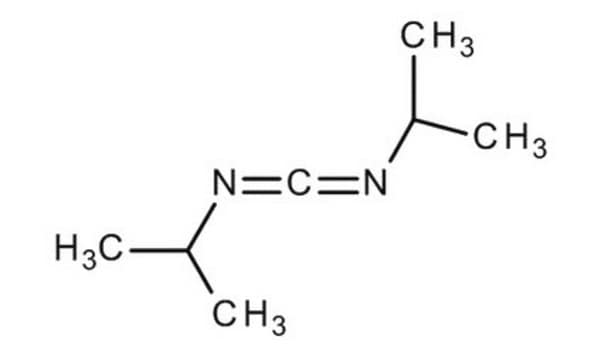The concentration of this product can be determined using the lot specific purity reported in the Certificate of Analysis, the density, and the compound molecular weight. This product has a density of 0.815 g/mL and a molecular weight of 126.20 g/mol. The minimum purity is 98.0%, thus the molarity will vary slightly from lot to lot. The molarity can range from 6.33M (98.0%) to 6.46M (100%).
38370
DIC
≥98.0% (GC), for peptide synthesis
Sinónimos:
N,N′-Diisopropilcarbodiimida
Seleccione un Tamaño
107,00 €
Seleccione un Tamaño
About This Item
107,00 €
Productos recomendados
Nombre del producto
DIC, purum, ≥98.0% (GC)
grado
purum
Nivel de calidad
Ensayo
≥98.0% (GC)
Formulario
liquid
idoneidad de la reacción
reaction type: Coupling Reactions
índice de refracción
n20/D 1.433 (lit.)
bp
145-148 °C (lit.)
densidad
0.815 g/mL at 20 °C (lit.)
0.815 g/mL at 20 °C
aplicaciones
peptide synthesis
grupo funcional
amine
cadena SMILES
CC(C)N=C=NC(C)C
InChI
1S/C7H14N2/c1-6(2)8-5-9-7(3)4/h6-7H,1-4H3
Clave InChI
BDNKZNFMNDZQMI-UHFFFAOYSA-N
Información sobre el gen
human ... EPHX2(2053)
mouse ... Ephx2(13850)
¿Está buscando productos similares? Visita Guía de comparación de productos
Categorías relacionadas
Descripción general
Aplicación
- To synthesize lanthanide (Ln) guanidinate complexes via insertion of carbodiimide into the Ln-N bond of lanthanocene secondary amido complexes.[2]
- To facilitate the cyclization of N-(β-Hydroxy)amides to form 2-oxazolines.[3]
- To synthesize 1-isopropyl-2-alkoxycarbonyl-3-isopropyliminio-aziridine by reacting with alkyl diazoacetates in the presence of transition metal salts.[4]
- A coupling reagent for the synthesis of various esters and amides by treating carboxylic acids with phenols and amines respectively.[5]
- A reagent for the conversion of alcohols to aldehydes or ketones in the presence of DMSO via modified Moffatt-type oxidation reaction.[1]
- A reagent to facilitates the preparation of alkyl halides from corresponding alcohols via the formation of o-alkylisourea.[6]
Producto relacionado
Palabra de señalización
Danger
Frases de peligro
Consejos de prudencia
Clasificaciones de peligro
Acute Tox. 1 Inhalation - Eye Dam. 1 - Flam. Liq. 3 - Resp. Sens. 1 - Skin Sens. 1
Código de clase de almacenamiento
3 - Flammable liquids
Clase de riesgo para el agua (WGK)
WGK 3
Punto de inflamabilidad (°F)
91.4 °F
Punto de inflamabilidad (°C)
33 °C
Equipo de protección personal
Eyeshields, Faceshields, Gloves, type ABEK (EN14387) respirator filter
Elija entre una de las versiones más recientes:
¿Ya tiene este producto?
Encuentre la documentación para los productos que ha comprado recientemente en la Biblioteca de documentos.
Los clientes también vieron
-
hi, what is the concentration of this product?
1 respuesta-
¿Le ha resultado útil?
-
Filtros activos
Nuestro equipo de científicos tiene experiencia en todas las áreas de investigación: Ciencias de la vida, Ciencia de los materiales, Síntesis química, Cromatografía, Analítica y muchas otras.
Póngase en contacto con el Servicio técnico













